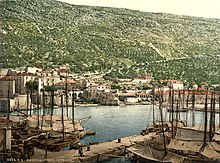Austria-Hungary
[citation needed] In the 1860s, the Empire faced two severe defeats: its loss in the Second Italian War of Independence broke its dominion over a large part of Northern Italy (Lombardy, Veneto, Modena, Reggio, Tuscany, Parma and Piacenza) while defeat in the Austro-Prussian War of 1866 led to the dissolution of the German Confederation (of which the Habsburg emperor was the hereditary president) and the exclusion of Austria from German affairs.The decisive victory of the Prusso-German armies in the Franco-Prussian war and the subsequent founding of the German Empire ended all hope of re-establishing Austrian influence in Germany, and Beust retired.Count Gyula Andrássy, a Hungarian who was Foreign Minister (1871–1879), made the centerpiece of his policy one of opposition to Russian expansion in the Balkans and blocking Serbian ambitions to dominate a new South Slav federation.[27] Russian Pan-Slavic organizations sent aid to the Balkan rebels and so pressured the tsar's government to declare war on the Ottoman Empire in 1877 in the name of protecting Orthodox Christians.British prime minister Benjamin Disraeli moved warships into position against Russia to halt the advance of Russian influence in the eastern Mediterranean so close to Britain's route through the Suez Canal.[34] A proclamation issued on the occasion of its annexation to the Habsburg monarchy in October 1908 promised these lands constitutional institutions, which should secure to their inhabitants full civil rights and a share in the management of their own affairs by means of a local representative assembly.[39] The 28 June 1914 assassination of Archduke Franz Ferdinand in the Bosnian capital, Sarajevo, excessively intensified the existing traditional religion-based ethnic hostilities in Bosnia.The foreign ministry of Austro-Hungarian Empire sent ambassador László Szőgyény to Potsdam, where he inquired about the standpoint of the German emperor, Wilhelm II, on 5 July and received a supportive response.As mentioned, he first had to consult with the Chancellor, but he did not have the slightest doubt that Herr von Bethmann Hollweg would fully agree with him, particularly with regard to action on our part against Serbia.Near the end of 1915, in a massive rescue operation involving more than 1,000 trips made by Italian, French and British steamers, 260,000 Serb soldiers were transported to Brindisi and Corfu, where they waited for the chance of the victory of Allied powers to reclaim their country.By the end of September 1916, Austria–Hungary mobilized and concentrated new divisions, and the successful Russian advance was halted and slowly repelled; but the Austrian armies took heavy losses (about 1 million men) and never recovered.Following the Armistice of 11 November 1918 ending the World War I, in spite of the previous initial total dependence of the kingdom on its sponsors, it ultimately served against their intentions as the cornerstone proto state of the nascent Second Polish Republic, the latter composed also of territories never intended by the Central Powers to be ceded to Poland.Italy was the only military opponent of Austria–Hungary which had a similar degree of industrialization and economic level; moreover, her army was numerous (≈1,000,000 men were immediately fielded), but suffered from poor leadership, training and organization.On 24 October 1917, Austrians (now enjoying decisive German support) attacked at Caporetto using new infiltration tactics; although they advanced more than 100 km (62.14 mi) in the direction of Venice and gained considerable supplies, they were halted and could not cross the Piave River.Italy also enjoyed the support of the Entente: by 1918, large amounts of war materials and a few auxiliary American, British, and French divisions arrived in the Italian battle zone.[30] After attacking Serbia, its forces soon had to be withdrawn to protect its eastern frontier against Russia's invasion, while German units were engaged in fighting on the Western Front.The military breakdown of the Italian front marked the start of the rebellion for the numerous ethnicities who made up the multiethnic Empire, as they refused to keep on fighting for a cause that now appeared senseless.One of Károlyi's first acts was to formally repudiate the compromise agreement on 31 October, effectively terminating the personal union with Austria and thus officially dissolving the Austro-Hungarian state.[21][91] After 1878, Bosnia and Herzegovina came under Austro-Hungarian military and civilian rule[15] until it was fully annexed in 1908, provoking the Bosnian crisis with the Great Powers and Austria-Hungary's Balkan neighbors, Serbia and Montenegro.[16] Relations during the half-century after 1867 between the two parts of the dual monarchy featured repeated disputes over shared external tariff arrangements and over the financial contribution of each government to the common treasury.In recognition that he reigned in a multi-ethnic country, Emperor Franz Joseph spoke (and used) German, Hungarian and Czech fluently, and Croatian, Serbian, Polish and Italian to some degree.[citation needed] Hungary's leaders were generally less willing than their Austrian counterparts to share power with their subject minorities, but they granted a large measure of autonomy to Croatia in 1868.But in spite of the constant renewal of negotiations for a compromise it was impossible to arrive at any agreement, until the outbreak of war left all the projects for a Ruthenian university at Lemberg, a Slovene one in Laibach, and a second Czech one in Moravia, unrealized.The strong agriculture and food industry of the Kingdom of Hungary with the centre of Budapest became predominant within the empire and made up a large proportion of the export to the rest of Europe.Near the actual "Iron Gates" strait the Prigrada rock was the most important obstacle until 1896: the river widened considerably here and the water level was consequently low.The yearly contingent of recruits for the army was fixed by the military bills voted on by the Austrian and Hungarian parliaments and was generally determined on the basis of the population, according to the last census returns.[169] The common minister of war was the head for the administration of all military affairs, except those of the Austrian Landwehr and of the Hungarian Honved, which were committed to the ministries for national defence of the two respective states.The Entente not only assumed without question that the minority peoples wished to leave Austria and Hungary, but allowed them to claim vast territories containing sizeable German- and Hungarian-speaking populations.With this in mind, in regard to areas without a decisive national majority, the Entente powers ruled in many cases in favour of the newly emancipated independent nation-states.[172] Finally, in March 1920, royal powers were entrusted to a regent, Miklós Horthy, who had been the last commanding admiral of the Austro-Hungarian Navy and had helped organize the counter-revolutionary forces.

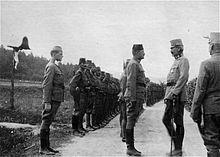


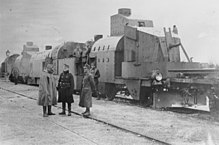

with military commanders during World War I

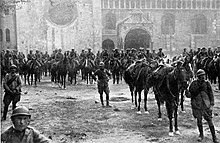



"Overwhelmed with joy, until recently enslaved and now free Nations announce that their wicked step-mother AUSTRIA the WITCH, operated in William’s Clinic, died from senility after severe spasms, cursed by all those who had the infelicity of having to do with her. Her dreadful funeral took place during these days in the fields of Macedonia, on the Piave River and across the Rhine . Let her rest in eternal peace and may she never raise from the dead.
POLES , CZECHO - SLOVAKS , YUGOSLAVS
Funeral home Wilson & Co."



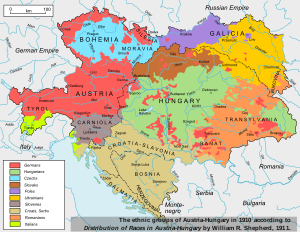






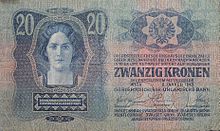



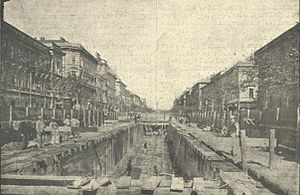

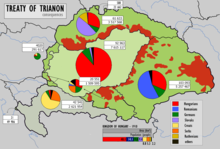
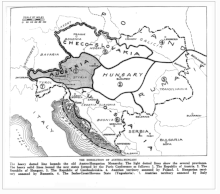

Border of Austria–Hungary in 1914
Borders in 1914
Borders in 1920
Empire of Austria
in 1914
Kingdom of Hungary
in 1914
Bosnia and Herzegovina
in 1914




Austria–Hungary relationsGermanHungarianCoat of armsFlags of Austria-HungaryIndivisibiliter ac inseparabiliterEnglishWorld War ICisleithaniaLands of the Crown of Saint StephenCondominium of Bosnia-HerzegovinaAustriaHungaryCondominiumViennaBudapestCroatianCroatia-SlavoniaPolishRuthenianRomanianBosnianSerbianSlovakSloveneItalianRomani (Carpathian)YiddishFriulianIstro-RomanianCatholicProtestantEastern OrthodoxJewishMuslimDemonym(s)GovernmentConstitutional monarchyFranz Joseph IKarl I & IVF. F. von BeustHeinrich LammaschGyula AndrássyMihály KárolyiTwo national legislaturesImperial CouncilHouse of LordsHouse of DeputiesDiet of HungaryHouse of MagnatesHouse of RepresentativesNew Imperialism1867 CompromiseDual AllianceBosnian CrisisJuly CrisisInvasion of SerbiaEmpire dissolvedAustrian RepublicHungarian RepublicTreaty of Saint-GermainTreaty of TrianonPopulationGulden / florinAustrian EmpireCzechoslovakiaPolandWest UkraineYugoslaviaRomaniaEmperor of AustriaKing of HungaryHabsburg monarchyAustro-Hungarian Compromise of 1867Austro-Prussian WarRussiaGerman EmpireBosnian Condominiumdual monarchyreal unionTransleithania (Kingdom of Hungary)Kingdom of Croatia-SlavoniaCroatian–Hungarian SettlementBosnia and Herzegovina came under Austro-Hungarian joint military and civilian ruleCentral PowersKingdom of Serbiadissolvedarmistice of Villa GiustiKingdom of HungaryFirst Austrian Republicsuccessors de jureFirst Czechoslovak RepublicSecond Polish RepublicKingdom of YugoslaviaKingdom of RomaniaKingdom of ItalySilver coinThe Kingdoms and Lands Represented in the Imperial CouncilLands of the Holy Hungarian Crown of St. StephenImperial and RoyalImperial-RoyalCrown of BohemiaTransleithaniaKingdom of Croatia and SlavoniaHistory of AustriaHallstatt cultureKingdom of NoricumRoman EraNoricumPannoniaRaetiaRugilandOdoacer's Kingdom of ItalyOstrogothic KingdomMarcomanniLombardsBaiuvariiCarantaniaFrankish KingdomEast FranciaMargraviate of AustriaHouse of BabenbergPrivilegium MinusHouse of HabsburgHoly Roman EmpirePrince-Archbishopric of Salzburg
